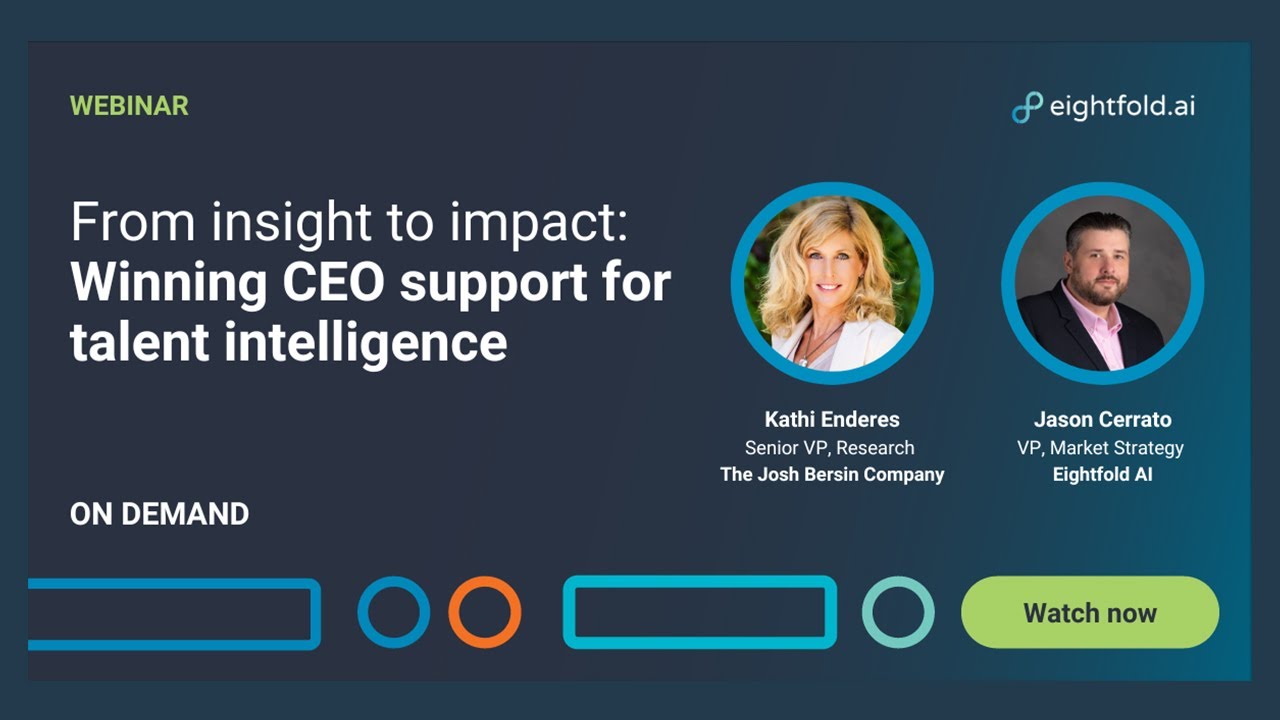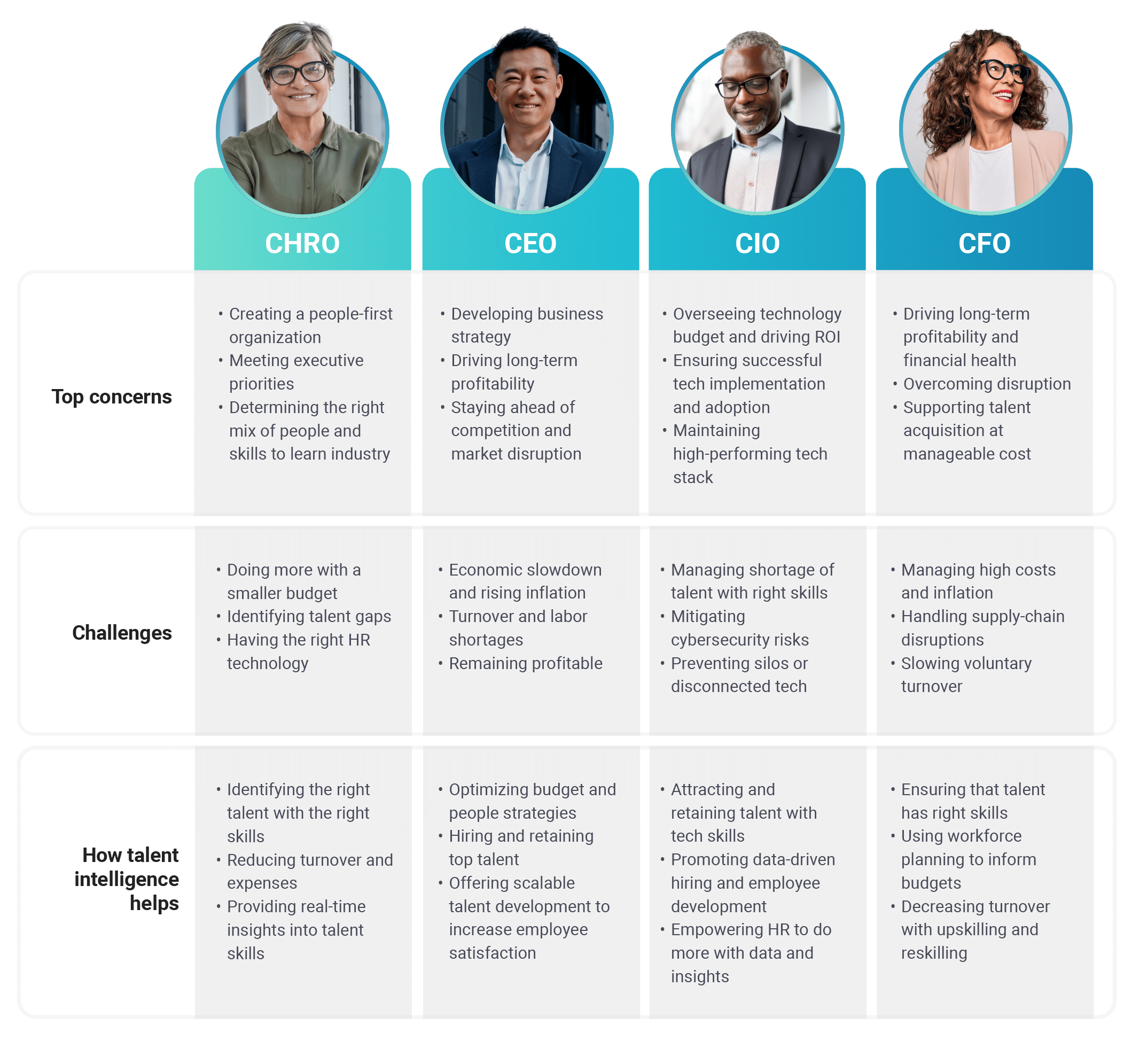- HR professionals know the value of talent intelligence, but the key to transforming your organization with AI-driven talent insights is executive buy-in.
- The C-suite needs to understand the business value of employee skills in getting work done that drives the organization forward.
- Articulating the business value means identifying one business problem, using talent intelligence to gain insights into that problem, speaking to the various concerns of each role in the C-suite, and citing business metrics.
Inevitably, when I speak to HR leaders about the value of talent intelligence, they’ll ask me how to secure executive buy-in. A talent intelligence initiative can transform the way an organization works and operates by informing and enhancing every stage of the talent life cycle. Since the C-suite is responsible for driving the culture, budgets, and business objectives, it’s absolutely critical to get their support for this kind of initiative.
Kathi Enderes, Senior Vice President of Research at The Josh Bersin Company, and I recently outlined why every executive needs to make talent intelligence a priority in 2024 — and the ways to win support from your C-suite.

Related content: Watch the entire webinar on Winning CEO support for talent intelligence, now on-demand.
Unlocking the power of real-time skills insights
While “real-time skills insights” might mean a lot to HR professionals, it’ll make more sense to executives to define what that means to the business. And right now, there’s a lot of discussion around the value of skills. Executives understand the need to keep up with the pace of change and to speed innovation. It’s what keeps them awake at night.
Knowing what skills employees have and what skills they need to serve the organization’s overall goals is essential to solving these executive concerns. But if your organization is managing talent by job descriptions alone, you’re not going to know. Job descriptions are not always accurate and often based on past needs, making it difficult to hire, retain, or develop talent for the actual work that needs to be done.
“Every time I talk with HR professionals, I ask them how long after they’re written a job description does it take until that job description is obsolete,” Enderes said. “More often than not, they’ll answer that it’s obsolete in a day or a week because a new technology, business model, or customer opportunity comes around to disrupt the market. When we think more about the underlying skills to do the work, it’s much more enduring, and much more flexible.”
From a talent management perspective, understanding skills enables you to know who has proficiency and how to develop it, which allows for better employee retention and mobility. Organizations can ask the questions about whether years of experience or college degrees are necessary. You can look at adjacent skills to tap into a much bigger and more diverse talent pool.
A skills-based approach, powered by AI, enables the entire organization to look at work differently and understand it in real time. This talent intelligence unlocks organizational agility by shifting the conversation from analyzing a supply of people to jobs, to optimizing work based on skills available to align with the business strategy. As you start to understand this, you can communicate these messages to the C-suite so they can see the value for shifting to this approach.
Related content: For more on how to talk to the C-suite about talent intelligence, read our e-book on how to get executive buy-in for AI.
Articulating the business case for talent intelligence
The first step in getting C-suite buy-in for talent intelligence is to identify the big business problem. Many times we’ve seen teams who start with the technology and try to show executives why the technology is important, but at the end of the day the C-suite are laser-focused on business problems and looking for ways to solve those. As HR professionals, you must narrow down the big problem that’s most prevalent.
Three common business problems that map directly to talent include skills gaps, capacity gaps, and/or misalignment.

Once you’ve identified the top business problem, the second step is to use talent intelligence to more deeply understand the problem. If you’re focusing on a skills gap, you might not be able to hire yourself out of this problem so the solution is reskilling. Do you know what skills your employees already have? How can you identify adjacent skills? Where are people with the right skills located geographically? Talent intelligence will give you these insights.
To solve a capacity gap problem, you need to know what skills are needed, what skills your talent has, and what skills are in the outside talent market. The skills you need might be in places you didn’t think of looking, but you wouldn’t discover this without talent intelligence. Redesigning current roles using talent intelligence enables you to understand the work that has to be done and organizing talent (either existing or external hired) based on skills.
If you’re trying to solve a misalignment problem, you need to understand where you can move talent to work that aligns with business objectives. You need talent intelligence to match the skills of those people to work that will enable the organization to reach those objectives.
The third step in articulating the business case for talent intelligence is to show the C-suite a proven systemic solution, like the Bersin Company’s 4R Framework — recruit, retain, reskill, and redesign.

Source: The Josh Bersin Company, 2022
Recruiting is now informed by an understanding of skills needed to grow. HR can inform executives that objectives can be met because the organization has the necessary skills.
Retaining employees in competitive industries becomes easier because the organization offers better career growth based on skills needed. HR can be in constant collaboration with the C-suite on objectives and the skills necessary to reach those objectives, which ties into reskilling and redesigning roles.
The Josh Bersin Company has done research using Eightfold’s AI-driven talent intelligence into organizations using this systemic solution and found that those implementing the Four Rs are not just industry leaders now, but also exponentially advancing their leads. These “pacesetter” companies have demonstrated high revenue growth, high market share, and high Glassdoor ratings.
Showing your C-suite this data drives the value of talent intelligence home. When executives can understand that organizing talent around the work that needs to be done can help the organization meet business objectives, increase revenue, and keep employees happy, that’s when there’s buy-in.
Engaging different members of the C-suite
How you phrase your communications with various executives in the C-suite makes a difference. You want to tailor your message to what matters most to each role. Focusing on the top three concerns and challenges is a good start, then connecting how talent intelligence would address those.

How you measure success for HR is different, too. It’s not enough to speak to executives about more efficiency in HR, or that the organization has high engagement or retention. It’s about adding business value. You need business measures like how your initiatives can enable the organization to grow, innovate, or increase customer satisfaction.
For a more in-depth discussion, I encourage you to watch the webinar. You’ll need the insights on why every executive must make talent intelligence a priority, and how to gain C-suite support for change and transformation.
Jason Cerrato is VP, Market Strategy, at Eightfold AI. Before joining Eightfold, he was an HCM industry analyst with Gartner and held talent leadership positions at United Technologies for over a decade. Cerrato is the co-host of The New Talent Code, a podcast by Eightfold AI.










